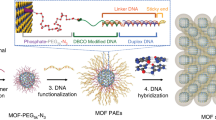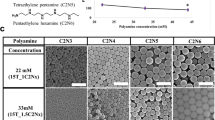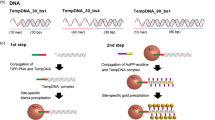Abstract
This protocol describes a method for encapsulating DNA into amorphous silica (glass) spheres, mimicking the protection of nucleic acids within ancient fossils. In this approach, DNA encapsulation is achieved after the ammonium functionalization of silica nanoparticles. Within the glass spheres, the nucleic acid molecules are hermetically sealed and protected from chemical attack, thereby withstanding high temperatures and aggressive radical oxygen species (ROS). The encapsulates can be used as inert taggants to trace chemical and biological entities. The present protocol is applicable to short double-stranded (ds) and single-stranded (ss) DNA fragments, genomic DNA and plasmids. The nucleic acids can be recovered from the glass spheres without harm by using fluoride-containing buffered oxide etch solutions. Special emphasis is placed in this protocol on the safe handling of these buffered hydrogen fluoride solutions. After dissolution of the spheres and subsequent purification, the nucleic acids can be analyzed by standard techniques (gel electrophoresis, quantitative PCR (qPCR) and sequencing). The protocol requires 6 d for completion with a total hands-on time of 4 h.
This is a preview of subscription content, access via your institution
Access options
Subscribe to this journal
Receive 12 print issues and online access
$259.00 per year
only $21.58 per issue
Buy this article
- Purchase on Springer Link
- Instant access to full article PDF
Prices may be subject to local taxes which are calculated during checkout





Similar content being viewed by others
References
Watson, J.D. & Crick, F.H.C. Molecular structure of nucleic acids— a structure for deoxyribose nucleic acid. Nature 171, 737–738 (1953).
Kedes, L. & Liu, E.T. The Archon Genomics X prize for whole human genome sequencing. Nat. Genet. 42, 917–918 (2010).
Paunescu, D., Fuhrer, R. & Grass, R.N. Protection and deprotection of DNA - high temperature stability of nucleic acid barcodes for polymer labeling. Angew. Chem. Int. Ed. 52, 4269–4272 (2013).
Choy, J.H., Kwak, S.Y., Park, J.S., Jeong, Y.J. & Portier, J. Intercalative nanohybrids of nucleoside monophosphates and DNA in layered metal hydroxide. J. Am. Chem. Soc. 121, 1399–1400 (1999).
Choy, J.H., Oh, J.M., Park, M., Sohn, K.M. & Kim, J.W. Inorganic-biomolecular hybrid nanomaterials as a genetic molecular code system. Adv. Mater. 16, 1181–1184 (2004).
Pinheiro, A.V., Han, D., Shih, W.M. & Yan, H. Challenges and opportunities for structural DNA nanotechnology. Nat. Nanotechnol. 6, 763–772 (2011).
Auyeung, E., Macfarlane, R.J., Choi, C.H.J., Cutler, J.I. & Mirkin, C.A. Transitioning DNA-engineered nanoparticle superlattices from solution to the solid state. Adv. Mater. 24, 5181–5186 (2012).
Mirkin, C.A., Letsinger, R.L., Mucic, R.C. & Storhoff, J.J. A DNA-based method for rationally assembling nanoparticles into macroscopic materials. Nature 382, 607–609 (1996).
Goldman, N. et al. Towards practical, high-capacity, low-maintenance information storage in synthesized DNA. Nature 494, 77–80 (2013).
Church, G.M., Gao, Y. & Kosuri, S. Next-generation digital information storage in DNA. Science 337, 1628 (2012).
Oskam, C.L. et al. Fossil avian eggshell preserves ancient DNA. Proc. R. Soc. B Biol. Sci. 277, 1991–2000 (2010).
Setlow, P. I will survive: DNA protection in bacterial spores. Trends Microbiol. 15, 172–180 (2007).
Setlow, P. Spores of Bacillus subtilis: their resistance to and killing by radiation, heat and chemicals. J. Appl. Microbiol. 101, 514–525 (2006).
Burgoyne, L.A. Solid medium and method for DNA storage. US patent 5,496,562 (1988).
Taylor, D.J., Finston, T.L. & Hebert, P.D.N. The 15% solution for preservation. Trends Ecol. Evol. 9, 230 (1994).
Yang, H. et al. Adsorption and protection of plasmid DNA on mesoporous silica nanoparticles modified with various amounts of organosilane. J. Colloid Interface Sci. 369, 317–322 (2012).
Kapusuz, D. & Durucan, C. Synthesis of DNA-encapsulated silica elaborated by sol-gel routes. J. Mater. Res. 28, 175–184 (2013).
Pierre, A., Bonnet, J., Vekris, A. & Portier, J. Encapsulation of deoxyribonucleic acid molecules in silica and hybrid organic-silica gels. J. Mater. Sci. Mater. Med. 12, 51–55 (2001).
Jin, C., Han, L. & Che, S. Synthesis of a DNA-silica complex with rare two-dimensional square p4mm symmetry. Angew. Chem. Int. Ed. 48, 9268–9272 (2009).
Numata, M., Sugiyasu, K., Hasegawa, T. & Shinkai, S. Sol-gel reaction using DNA as a template: an attempt toward transcription of DNA into inorganic materials. Angew. Chem. Int. Ed. 43, 3279–3283 (2004).
Stober, W., Fink, A. & Bohn, E. Controlled growth of monodisperse silica spheres in micron size range. J. Colloid Interface Sci. 26, 62–69 (1968).
Sanger, F., Nicklen, S. & Coulson, A.R. DNA sequencing with chain-terminating inhibitors. Proc. Natl. Acad. Sci. USA 74, 5463–5467 (1977).
Aruoma, O.I., Halliwell, B., Gajewski, E. & Dizdaroglu, M. Copper-ion-dependent damage to the bases in DNA in the presence of hydrogen peroxide. Biochem. J. 273, 601–604 (1991).
Scalzo, A.J. & Blume-Odom, C.M. In Haddad and Winchester's Clinical Management of Poisoning and Drug Overdose (eds. Shannon, M.W., Borron, S.W. & Burns, M.) Ch. 90, Saunders, 1323–1335 (2007).
Mullins, M.E., Warden, C.R. & Barnum, D.W. Pediatric death and fluoride-containing wheel cleaner. Ann. Emerg. Med. 31, 524–525 (1998).
Featherstone, J.D.B. The science and practice of caries prevention. J. Am. Dent. Assoc. 131, 887–899 (2000).
Klasner, A.E., Scalzo, A.J., Blume, C., Johnson, P. & Thompson, M.W. Marked hypocalcemia and ventricular fibrillation in two pediatric patients exposed to a fluoride-containing wheel cleaner. Ann. Emerg. Med 28, 713–718 (1996).
Acknowledgements
We thank the Institute for Chemical and Bioengineering (ICB) at ETH Zurich, the EU-ITN network Mag(net)icFun (PITN-GA-2012-290248) and the Swiss National Science Foundation (no. 200021-150179) for financial support. We also thank W.J. Stark for helpful discussions.
Author information
Authors and Affiliations
Contributions
R.N.G. elaborated the concept. D.P., M.P., J.O.B.S. and R.N.G. developed and optimized the protocol. P.R.S. performed electron microscopy. D.P., M.P., P.R.S. and R.N.G. wrote the paper.
Corresponding author
Ethics declarations
Competing interests
R.N.G. declares financial interest in the form of a patent application (no. WO2013/143014) on DNA encapsulation licensed to TurboBeads, LLC, of which R.N.G. is a shareholder and employee. The remaining authors are employed by ETH Zurich and have no competing financial interests.
Rights and permissions
About this article
Cite this article
Paunescu, D., Puddu, M., Soellner, J. et al. Reversible DNA encapsulation in silica to produce ROS-resistant and heat-resistant synthetic DNA 'fossils'. Nat Protoc 8, 2440–2448 (2013). https://doi.org/10.1038/nprot.2013.154
Published:
Issue Date:
DOI: https://doi.org/10.1038/nprot.2013.154
This article is cited by
-
Unlocking the potential of DNA-based tagging: current market solutions and expanding horizons
Nature Communications (2023)
-
Dissolution control and stability improvement of silica nanoparticles in aqueous media
Journal of Nanoparticle Research (2023)
-
Silica nanoparticles with encapsulated DNA (SPED) to trace the spread of pathogens in healthcare
Antimicrobial Resistance & Infection Control (2022)
-
Synthetic DNA applications in information technology
Nature Communications (2022)
-
Long-term whole blood DNA preservation by cost-efficient cryosilicification
Nature Communications (2022)
Comments
By submitting a comment you agree to abide by our Terms and Community Guidelines. If you find something abusive or that does not comply with our terms or guidelines please flag it as inappropriate.



